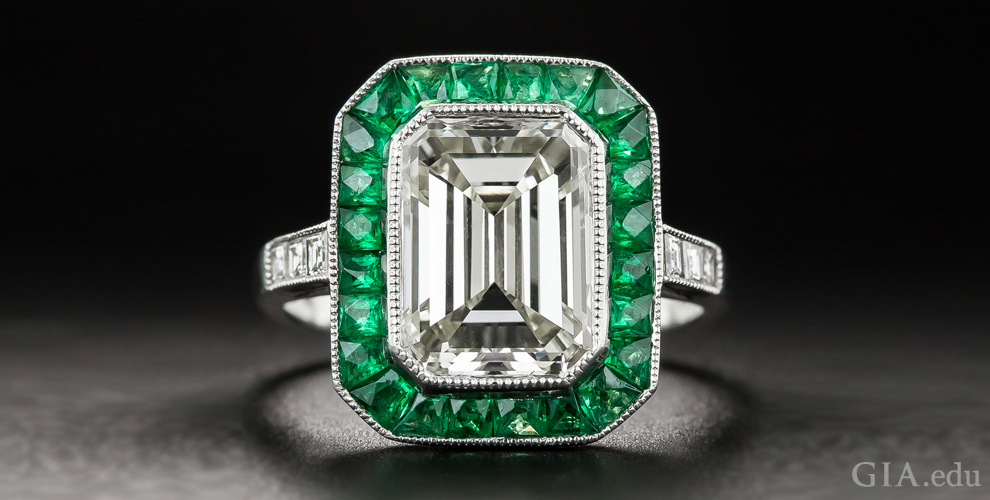Antique and vintage engagement rings are in fashion – and for good reason. They have an undeniable charm and style. They are a beautiful piece of the past. They’re lasting symbols of love. Here’s how to pick one that you’ll cherish.
In this blog, we cover:
Establishing a budget for antique and vintage engagement rings
Understanding the difference between antique and vintage engagement rings
Important jewelry periods for antique and vintage engagement rings
Diamond cuts typical of antique and vintage engagement rings
Challenges with buying antique and vintage engagement rings
Where to find antique and vintage engagement rings
Establishing a budget for antique and vintage engagement rings
Prices for antique and vintage engagement rings run the gamut from less than $1,000 to more than $100,000. Put another way, there are beautiful rings for every budget. Deciding what to spend is a personal decision that balances practicality and love. You know what’s best for your circumstances.
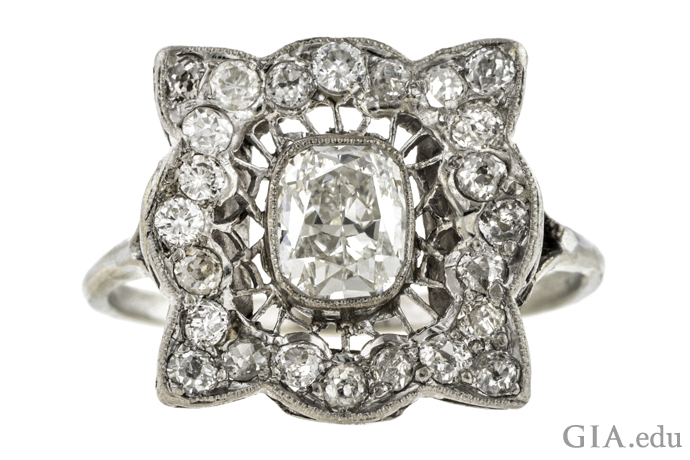
If you’re looking for an antique engagement ring, aristocratic elegance is a hallmark of the Edwardian era. In this intricate creation, a 1.12 carat (ct) cushion cut diamond nestles within approximately 0.48 carats of diamond melee. Courtesy: Doyle & Doyle
Understanding the difference between antique and vintage engagement rings
Before we dive into the details of shopping for antique and vintage engagement rings, here are a few terms you need to know:
- Antique: Jewelry made more than 100 years ago
- Vintage: Jewelry that is not contemporary, but not old enough to be antique
- Estate: Preowned jewelry – can be antique, vintage or contemporary
Understanding the difference between antique and vintage engagement rings will be helpful for your search. If you’re interested in an engagement ring from a specific period, like the Victorian era, you’ll want to use the proper terminology to help the retailer find the appropriate pieces. It also shows that you’re an educated customer.

With its heart shaped moonstone cradled in a halo of diamonds, this Victorian era engagement ring sparkles with romance. Courtesy: 1stdibs.com
Important jewelry periods for antique and vintage engagement rings
Throughout history, certain periods or cultural movements have had a signature jewelry style. Your delightful challenge will be finding antique and vintage engagement rings and choosing one that best captures the spirit of your love. Here are brief descriptions of rings made during some of the more important jewelry periods.
- Victorian (1837–1901): During the long reign of Queen Victoria, engagement rings featured a number of romantic design motifs, including acrostics (using the first letter of gemstones to spell a word), serpents, flowers, hearts and more. With the discovery of diamonds in South Africa during the latter half of her reign, diamonds became more common. The Victorian era spanned many decades, so you’re likely to find antique engagement rings from this era that charm your heart and eye.
Learn more about Victorian style engagement rings.

An engagement ring with a snake motif might seem unusual to modern eyes. To Victorians, the serpent symbolized love, eternity and wisdom. Two coiled serpents are set with ruby, diamond and emerald. Courtesy: 1stdibs.com
- Art Nouveau (1890s–early 1910s): Antique engagement rings of this period can be identified by the use of sinuous whiplash lines, enamel and unusual colored gems. Jewelry designers were strongly inspired by nature. They made fantastical pieces often depicting peacocks, swans, swallows, bats, dragonflies and butterflies, as well as the feminine form. Asymmetry (a lack of proportion between two parts of an object) and the economy of line (the elimination of non-essential elements) are other signature design features of this period.
Learn more about Art Nouveau engagement rings.

Dramatic swirling lines, a signature of Art Nouveau jewelry, infuse this ring with a sense of movement while diamonds add sparkle. Courtesy: 1stdibs.com
- Edwardian (1890s–1915): Triumphal laurel wreaths, scrolls, feathers, tassels, ribbons tied in bowknots, garlands of flowers, platinum and diamonds gave Edwardian era engagement rings a regal look, in keeping with the fashion established by Victoria’s heir, King Edward VII. The marquise cut diamond was also in fashion; the elegant shape was supposedly named for the Marquise de Pompadour, a mistress of France’s King Louis XV, because its outline resembled the shape of her mouth.
Learn more about Edwardian engagement rings.

This 1.63 ct elongated oval diamond is surrounded by milgrain and delicate open work that are characteristic of the Edwardian era. Courtesy: LangAntiques.com
- Art Deco (1920s–1930s): For engagement rings of this period, look for geometric patterns and abstract designs brought to life with diamonds and gems of contrasting colors. Triangles, squares, rectangles and other geometric patterns were used to evoke the streamlined, modern spirit of the time. If you love a simple, yet bold style, then Art Deco vintage engagement rings would suit your taste.
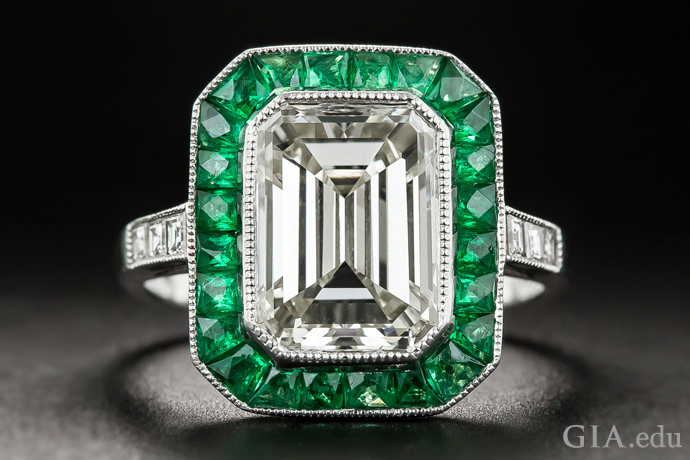
A 3.00 ct emerald cut diamond bordered by emeralds captures the geometric patterns and contrasting colors that are classic Art Deco. Courtesy: LangAntiques.com
Learn more about Art Deco engagement rings.
- Retro (mid-1930s to the 1950s): Retro era engagement rings featured the geometric shapes of the Art Deco era but softened them with curves. Gold, especially rose gold, was the metal of choice. Expect to see these vintage engagement rings set with rubies, sapphires, emeralds, topaz, citrine, green beryl and aquamarine. Diamonds tended to be small, so jewelers used techniques like the illusion setting to make them appear larger. Designs were inspired by mechanical objects such as bicycle chains and padlocks.
Learn more about Retro-style engagement rings.

Wearable sculpture is a perfect way to describe this Retro era engagement ring. The diamonds shine brighter for being juxtaposed against rubies. Courtesy: Lang Antiques.com
Diamond cuts typical of antique and vintage engagement rings
If you’re looking for antique engagement rings, you’re likely to come across the terms old mine cut and old European cut diamonds.
An old mine cut diamond is a squarish or cushion shaped brilliant with many proportion variations that was often used in jewelry during the Georgian (1714–1837) and early to mid-Victorian periods. Although it has 58 facets like most modern round brilliant cut diamonds, it typically has a smaller table, larger culet and higher crown. It also has short lower half facets and a girdle that is very thin in places, which contribute to its distinctive look.
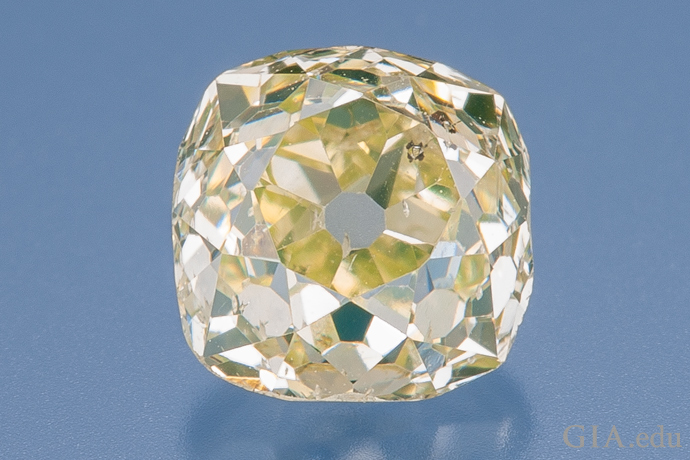
No two old mine cut diamonds are identical. This one weighs 0.68 ct. Photo: Orasa Weldon/GIA
The old European cut emerged as advances in diamond cutting technology in the late 1800s made it possible to fashion round girdles, like the modern round brilliant, though it has a higher crown, very small table and greater total depth. It is typically found in jewelry from the late Victorian era, the Edwardian era and the Art Deco period.

This 0.99 ct old European cut diamond has a stately elegance. Photo: Orasa Weldon/ GIA
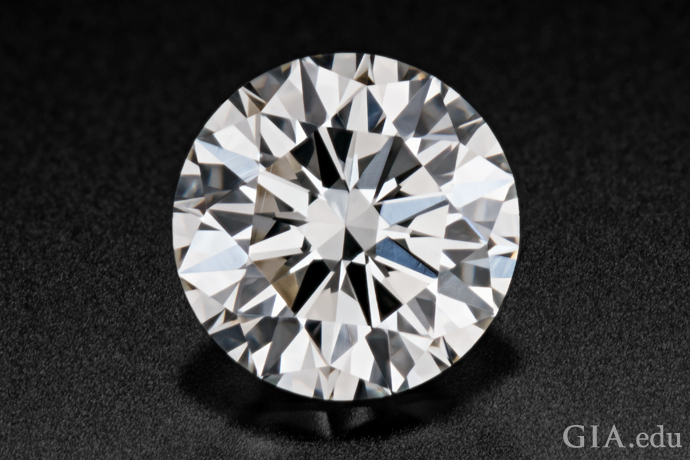
The round brilliant cut diamond, here at 0.73 carats, has been the standard for engagement rings since the mid-20th century. Photo: Kevin Schumacher/GIA
Challenges with buying antique and vintage engagement rings
Antique and vintage engagement rings can be a unique choice for your bride-to-be, but there are some challenges you should be aware of before you make a purchase.
- Synthetic Gems and Simulants:
When shopping for antique and vintage engagement rings, it’s not uncommon to find some set with synthetic gems or simulants. Synthetic rubies have been around since the late 1800s, and both synthetic rubies and sapphires were very popular in the early to mid-1900s as they made jewelry more affordable. During the Art Deco era in particular, small calibré cut synthetic rubies and sapphires often served to accent diamonds in engagement rings and other jewelry. By the middle of the 20th century, synthetic emerald was also available, and by the 1970s we had synthetic alexandrite, opal, turquoise, citrine and amethyst, among others.
Simulants, like garnet-and-glass doublets in different colors (not just red, but also blue, green and even colorless) and other imitations, were commonly used in place of natural gemstones. Synthetics and simulants were often mixed with natural gems or diamonds. Over the years, fine gems in some pieces of antique or vintage jewelry have been removed and replaced with less-expensive imitations. The bottom line: Don’t assume that just because a ring is older, the stones are natural. - Thinning Prongs and Shanks:
With time, prongs on antique and vintage engagement rings can weaken from years of wear. When prongs are thin or worn, they can’t hold the stone as securely, making it vulnerable to loss. Retipping a prong usually requires removal and resetting of the stone, which always comes with some level of risk. Similarly, the back of the shank may be too thin on some rings, so it may need to be replaced with a new quarter shank or half shank. - Resizing Issues:
Antique and vintage engagement rings can be very difficult to resize, especially to go significantly larger or smaller. Consult with your jeweler on how to determine ring size before you buy. - Return Policy:
What happens if the engagement ring you bought doesn’t meet your expectations (or those of your bride-to-be) when you get it home? Our suggestion: Make sure the retailer has a generous and fair return policy. You should insist on having at least seven days to return an item.
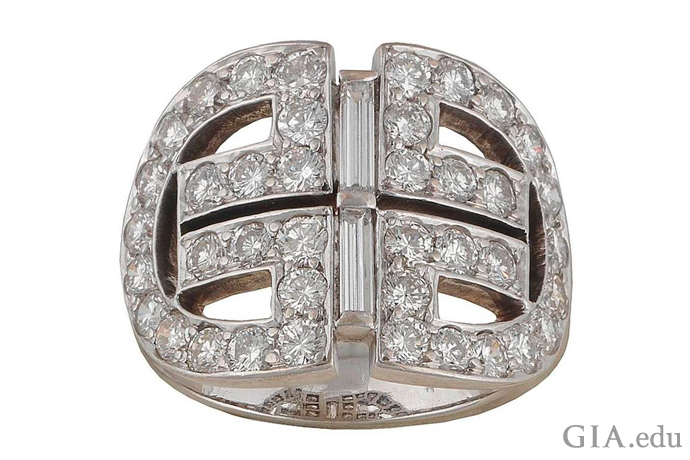
A distinctive geometric pattern with both strong angles and curves incorporates two baguette diamonds weighing approximately 0.60 carats and about 2.00 carats of melee in this Retro era ring. Courtesy: 1stdibs.com
Where to find antique and vintage engagement rings
A number of websites specialize in antique and vintage engagement rings. To determine if an online retailer is trustworthy, look to see how long they have been in business and if they are in good standing with the Better Business Bureau. Be sure to speak with retailers directly both to get answers to your questions and see if they are knowledgeable professionals. It is wise to purchase items with diamonds that come with GIA Grading Reports. Our blog on the Five Non-Negotiable Rules for Buying Jewelry Online has more essential information that may be helpful during your search.
Auction catalogs and websites that sell estate jewelry are two other sources. In addition, you can search the GIA Retailer Lookup for retailers who carry GIA-graded diamonds. Some of them also sell antique and vintage engagement rings, so it may be a good place to start.
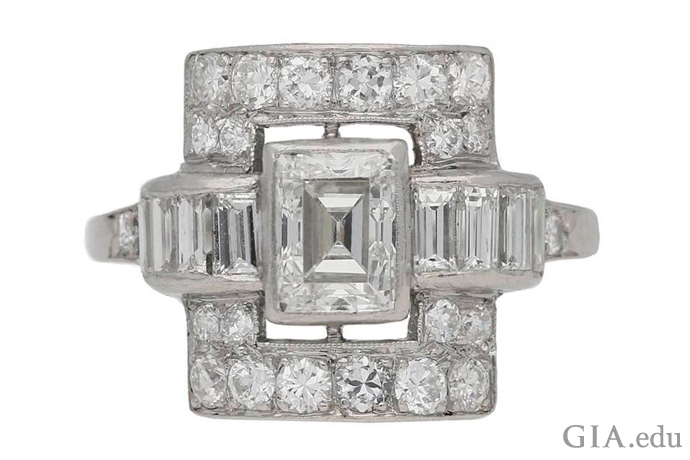
Contrasting geometric shapes create a sum greater than its parts in this Art Deco ring. A 0.85 ct octagonal emerald cut diamond is the center stone, accompanied by eight rectangular baguette cut diamonds and a group of round old European cut diamonds. Courtesy: 1stdibs.com
Once you find your perfect antique or vintage engagement ring, consider getting an unbiased appraisal from an experienced jeweler or independent jewelry appraiser. The appraisal should provide you with a full description of the piece, including its condition, as well as validate its historical period and estimate its value.
Searching for antique and vintage engagement rings can be like going through a treasure chest filled with lots of precious surprises. If you’re having a tough time finding one that’s right for you, consider creating a custom engagement ring with these antique and vintage styles in mind.
